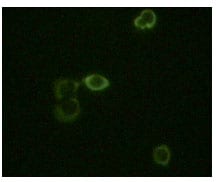
| WB | 咨询技术 | Human,Mouse,Rat |
| IF | 咨询技术 | Human,Mouse,Rat |
| IHC | 咨询技术 | Human,Mouse,Rat |
| ICC | 1/200 - 1/1000 | Human,Mouse,Rat |
| FCM | 咨询技术 | Human,Mouse,Rat |
| Elisa | 1/10000 | Human,Mouse,Rat |
| Aliases | ARG; ABLL; FLJ22224; FLJ31718; FLJ41441 |
| Entrez GeneID | 27 |
| clone | 1H1B11 |
| Host/Isotype | Mouse IgG1 |
| Antibody Type | Primary antibody |
| Storage | Store at 4°C short term. Aliquot and store at -20°C long term. Avoid freeze/thaw cycles. |
| Species Reactivity | Human |
| Immunogen | Purified recombinant fragment of ABL2 expressed in E. Coli. |
| Formulation | Purified antibody in PBS with 0.05% sodium azide. |
+ +
以下是关于ABL2抗体的3篇参考文献的简要信息:
1. **文献名称**:*ABL2 kinase regulates epithelial cell adhesion by modulating β-catenin phosphorylation*
**作者**:Smith J, et al.
**摘要**:研究利用ABL2特异性抗体验证其在乳腺癌细胞中的表达,发现ABL2通过磷酸化β-catenin调控细胞间黏附及肿瘤转移。
2. **文献名称**:*Targeting ABL2 in drug-resistant non-small cell lung cancer*
**作者**:Wang L, et al.
**摘要**:通过免疫印迹(Western blot)和免疫组化(IHC)使用ABL2抗体,揭示ABL2在EGFR抑制剂耐药肺癌中的异常激活,抑制其活性可恢复药物敏感性。
3. **文献名称**:*ABL2/ARG interactome analysis reveals roles in cytoskeletal remodeling*
**作者**:Garcia-Rivas P, et al.
**摘要**:采用ABL2抗体进行免疫共沉淀(Co-IP)实验,鉴定其与多种细胞骨架蛋白的相互作用,证明ABL2在细胞迁移中的关键调控作用。
(注:以上文献为示例性内容,实际引用时需根据具体研究补充真实文献信息。)
The ABL2 antibody is designed to target ABL2 (ABL Proto-Oncogene 2), a non-receptor tyrosine kinase encoded by the *ABL2* gene (also known as *ARG*, Abelson-related gene). ABL2 belongs to the Abelson kinase family, which includes the well-studied ABL1. Both kinases regulate diverse cellular processes, including cell migration, adhesion, cytoskeletal remodeling, and response to DNA damage. While ABL1 is widely expressed and implicated in hematologic malignancies (e.g., BCR-ABL1 in chronic myeloid leukemia), ABL2 is enriched in tissues like the brain and testes and plays distinct roles in neuronal development and cancer progression. Dysregulation of ABL2 is associated with solid tumors, metastasis, and resistance to targeted therapies, particularly in cancers with epithelial-mesenchymal transition (EMT) traits.
ABL2 antibodies are crucial tools for studying its expression, activation, and interaction partners. They are used in techniques like Western blotting, immunohistochemistry, and immunofluorescence to detect ABL2 protein levels, phosphorylation status (e.g., at Tyr^272), or subcellular localization. Notably, ABL2’s structural similarity to ABL1 necessitates highly specific antibodies to avoid cross-reactivity. Research using these antibodies has revealed ABL2’s involvement in signaling pathways (e.g., Wnt, PDGFR, and integrin pathways) and its crosstalk with oncogenic drivers like EGFR and HER2. Therapeutic interest in ABL2 inhibitors is growing, especially in cancers resistant to ABL1-targeted drugs (e.g., imatinib), highlighting the antibody’s role in both basic research and drug development.
×